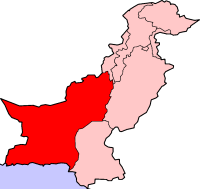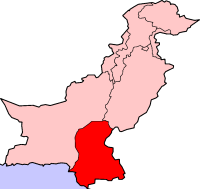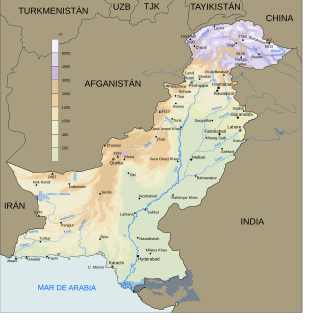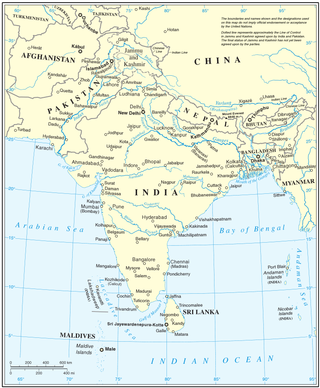
Shahdadkot is the most populated and largest Tehsil of Qambar Shahdadkot District of Sindh, Pakistan. It was named after the town founder Shahdad Khan Khuhawar. It is located around 51 kilometres northwest of Larkana and 34 kilometers north of Qambar. The town is in close proximity to three districts of Balochistan namely Khuzdar, Jhal Magsi and Jaffarabad in the west and north of the district. It is linked on the M8 motorway route between Gwadar and Ratodero.

Pakistan's climate varies from a continental type of climate in the north, a mountainous dry climate in the west (Baluchistan), a wet climate in the East (Punjab) an arid climate in the Thar Desert, to a tropical climate in the southeast (Sindh), characterized by extreme variations in temperature, both seasonally and daily, because it is located on a great landmass barely north of the Tropic of Cancer.

Very Severe Cyclonic Storm Phet was a powerful tropical cyclone that made landfall on Oman, Western India, and Pakistan. The third named cyclone of the 2010 cyclone season, Phet developed in the Arabian Sea on May 31 to the west of India. With conducive environmental conditions, the storm intensified to reach peak sustained winds of 155 km/h (95 mph) on June 2, based on analysis by the India Meteorological Department (IMD). On the next day, Phet dropped heavy rainfall while moving across eastern Oman, with a peak of 603 mm (23.7 in) in Qurayyat. The rains flooded arid areas and collected into wadis – normally dry river beds. Thousands of homes were wrecked across Oman. There were 24 fatalities in the country, and damage was estimated at US$780 million.

The floods in Pakistan began in late July 2010, resulting from heavy monsoon rains in the Khyber Pakhtunkhwa, Sindh, Punjab and, Balochistan regions of Pakistan, which affected the Indus River basin. Approximately one-fifth of Pakistan's total land area was affected by floods, with the Khyber Pakhtunkhwa province facing the brunt of the damage and casualties. Nationwide, there were 1,985 deaths. According to Pakistani government data, the floods directly affected about 20 million people, mostly by destruction of property, livelihood and infrastructure.

The 2011 Balochistan floods started from the last week of February and continued until the first week of March. Balochistan province was already badly affected from last year's devastating floods as UNHCR claims that 166,000 flood victims are still homeless in the province with 240 people still living in camps.

The 2011 Sindh floods was the highest-ever recorded rainfall between 11 August 2011, and 14 September 2011 in Sindh Province, Pakistan.
The 2012 Pakistan floods began in early September 2012, resulting from heavy monsoon rains in Khyber Pakhtunkhwa, Upper Sindh, Southern Punjab and Balochistan regions of Pakistan.

In September 2014, the Kashmir region suffered disastrous floods across many of its districts caused by torrential rainfall. The Indian state of Jammu and Kashmir, as well as the Pakistani territories of Azad Kashmir, Gilgit-Baltistan and the province of Punjab were affected by these floods. By 24 September 2014, nearly 277 people in India and about 280 people in Pakistan had died due to the floods.

Following heavy rain, Gujarat state of India was affected by the flood in July 2015. The flood resulted in at least 72 deaths.

The 2015 South India floods resulted from heavy rainfall generated by the annual northeast monsoon in November–December 2015. They affected the Coromandel Coast region of the South Indian states of Tamil Nadu and Andhra Pradesh. More than 500 people were killed and over 1.8 million people were displaced. With estimates of damages and losses ranging from nearly ₹200 billion (US$3 billion) to over ₹1 trillion (US$13 billion), the floods were the costliest to have occurred in 2015, and were among the costliest natural disasters of the year.
From February to April 2019, widespread flash flooding affected large parts of Pakistan, most severely in Balochistan, KPK, Punjab, and other provinces. Pakistan has been hit by three major waves of rain and flooding over the course of more than one month. The first wave of rain began on 20 February, leading to flooding in to Khyber and Balochistan, therefore many villages and several cities have been evacuated, and more than 1,500 families has been rescued alone in Balochistan and many in other states. The 20 February rain and thunderstorms caused flash floods in the Lasbela area. The main areas affected were Turbat, Tump, Nasirabad and Dasht where 300 people were displaced due to the flood. These people were then moved to camps established by the Provincial Disaster Management Authority (PDMA). Casualties have came mostly due to roof collapsing amid heavy rains and flash flooding. Khyber Pakhtunwkha has witnessed the most deaths till now, 40, alongside Balochsitan has faced 26 casualties with more than 9 in Punjab and other places. Due to rain, flood and storm casualties are increasing.

On 8 August 2019, due to heavy rainfall in the monsoon season, severe flood affected Kerala. As a security measure in the prevailing situation of heavy rains, the India Meteorological Department had issued a red alert in the 9 districts in Northern and Central Kerala, orange alert in 3 districts of Central Kerala, and yellow alert in the 2 districts of southern Kerala. Thousands of people have been evacuated to safer places and relief camps. A total of 121 people have died due to rain-related incidents as of 19 August 2019.
The COVID-19 pandemic in Pakistan is part of the ongoing pandemic of coronavirus disease 2019 caused by severe acute respiratory syndrome coronavirus 2. The virus was confirmed to have reached Pakistan on 26 February 2020, when two cases were recorded. On 18 March 2020, cases had been registered in all four provinces, the two autonomous territories, and Islamabad Capital Territory, and by 17 June, each district in Pakistan had recorded at least one confirmed case of COVID-19.

In 2016 Pakistan experienced higher rainfall than normal (10-20%), especially in the pre-monsoon season. Heavy monsoon rains are common in the region. This led to multiple periods of flooding, landslides, and damage particularly in Northern Pakistan. The Swat River overflowed and multiple landslides occurred around Pakistan including in Khyber Pakhtunkhwa, Gilgit-Baltistan, Azad Jammu, and Kashmir.

From 15 June to October 2022, floods in Pakistan killed 1,739 people, and caused ₨ 3.2 trillion of damage and ₨ 3.3 trillion of economic losses. The immediate causes of the floods were heavier than usual monsoon rains and melting glaciers that followed a severe heat wave, both of which are linked to climate change.

From January to October 2022, excessive rainfall and widespread monsoon flooding occurred in the South Asian countries of Afghanistan, Bangladesh, India, Nepal, Pakistan, and Sri Lanka. It has become the region's deadliest floods since 2020, with over 3,700 people dead.
Since 12 April 2024, heavy rains, lightning, and flash flooding in both Afghanistan and Pakistan killed more than 130, and injured many more. The floods were caused by unseasonal heavy rains, lightning and storms that swept across the two neighboring countries. The floods caused extensive damage to infrastructure and agriculture on both sides of the border.












